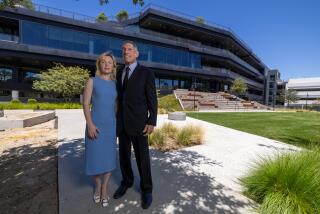UCLA Picked for Study of Hazardous Waste Control
- Share via
The National Science Foundation has awarded an $18-million grant to UCLA to open the nation’s first engineering research center devoted entirely to solving the growing problem of hazardous waste management, the university announced Monday.
The center, one of dozens backed by the Reagan Administration to expand basic research in fields ranging from telecommunications to biotechnology, will open in May.
While universities have long been engaged in various hazardous waste projects, the new Engineering Research Center for Hazardous Substance Control for the first time will bring together specialists from academia, government and industry and focus their expertise on hazardous waste.
“This center promises to be one of the most exciting projects that any engineering faculty has ever undertaken. It represents a unique opportunity for academic engineers to work together and with industry . . . on a vital national problem,” said the new center’s director, Prof. Sheldon K. Friedlander, chairman of UCLA’s chemical engineering department.
The center will draw from professors and students in chemical, electrical, civil, materials and mechanical engineering as well as others from the environmental science and engineering program of the School of Public Health, the Graduate School of Architecture and Urban Planning, and the Graduate School of Library and Information Science, which will establish a national information center on hazardous substances.
Backers of the new center said they hope that it will become to hazardous substance control what the Jet Propulsion Laboratory in Pasadena is to space exploration--a major national resource whose basic research and engineering innovations can be transferred to the marketplace to help meet the demands of both environmental protection and industry’s need for economical and efficient pollution control technology.
At the same time, the center will be a teaching laboratory for training new engineers and scientists who, Friedlander said, will be “sensitive to environmental constraints” as well as to the practical problems of persuading government and industry to see the benefits of new technology.
Mentioned by Reagan
President Reagan referred to the new research centers in his State of the Union address last January, declaring that they would help maintain the nation’s “competitiveness.”
The $18-million National Science Foundation grant will cover a five-year period, with the first $2 million allocated for 1987. In addition, another $4.4 million will be allocated by the state of California, the University of California and industry.
In addition to the professors and others involved, the research center will employ 25 graduate student trainees and 10 undergraduates beginning in May. Next year, those numbers will double.
The center will have a policy advisory group composed of representatives of business and industry to assure close cooperation with non-academic organizations. It is to be chaired by H. Ray Kerby, director of environmental programs for IBM. Other corporations involved in the center’s formation include Arco, TRW, Rockwell International, General Motors, Lockheed, Rand and America Ecology. The center’s executive director is Howard A. Slack, an adjunct professor at UCLA and formerly senior vice president of science and technology for Arco.
Purposes Detailed
William Chamberlain, senior vice president of Arco, stressed Monday that new federal Superfund legislation designed to clean up hazardous waste sites and impose new controls on hazardous materials at factories has left business and industry with little choice but to seek technological solutions. He said the time for simply calling for new studies as a delaying tactic has passed.
“I think the scope and impact of Superfund 1986 has not yet been appreciated,” Chamberlain said at a UCLA press conference. “It is going to have reverberations, I think a healthy one in general. Industry, if it were so inclined, would no longer have the option of delaying by study. If anything, I think we’re hungry for this technology to allow us to cope with the regulations that we now face.”
Friedlander noted that the cost of managing hazardous waste is approaching $10 billion annually for industry. He said that unless better methods are found, not only will the environment continue to be compromised, but the cost of goods manufactured in the United States could “significantly increase” with a consequent loss of market share to foreign manufacturers.






